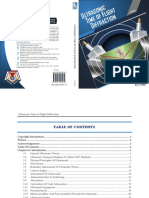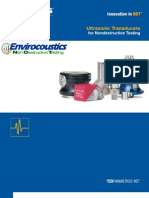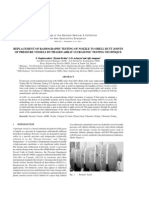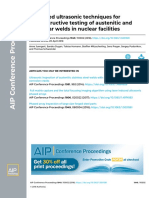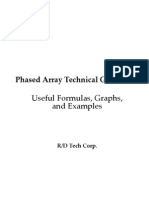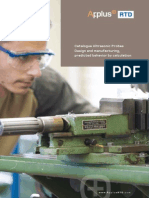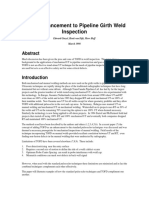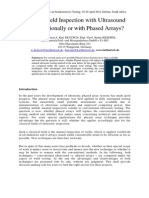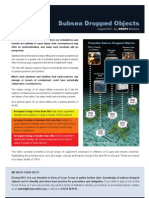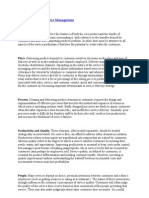TOFD
TOFD
Uploaded by
Davood Mohammad NejadCopyright:
Available Formats
TOFD
TOFD
Uploaded by
Davood Mohammad NejadCopyright
Available Formats
Share this document
Did you find this document useful?
Is this content inappropriate?
Copyright:
Available Formats
TOFD
TOFD
Uploaded by
Davood Mohammad NejadCopyright:
Available Formats
Linear Scanning Ultrasonic Inspection Developments with TOFD in Brazil, for the Replacement of Radiography and Manual Ultrasonic
Inspection.
F. Moreira, NDT do Brasil, Sao Paulo, Brasil E. Ginzel,
Materials Research Institute, Waterloo, Canada March 2003
Keywords TOFD, linear scanning, Code Case 2235 Abstract:
A rapid detection technique has been developed using a computerized ultrasonic system with a multi-probe array. The technique allows rapid detection of flaws, precise sizing capabilities and a safe and economical replacement for radiography and manual ultrasonic. This combination of TOFD and Pulse-Echo techniques allow conformance to AMSE Code Case 2235. Examples of 4 significantly different projects carried out in Brazil will be provided.
Background
The concept of linear scanning is not new to ultrasonic testing. This has been the standard technique for weld inspections of ERW and SAW welded joints in pipe mills for several decades. In 1997 one of the authors worked on a programme to inspect offshore oil platform structures (1) where a motorised scanner was used on butt welds and adapted to the requirements of API RP2X. By linear ultrasonic scanning we mean that probe motion is parallel to the weld axis while the beam is directed towards the weld. In contrast, a raster scan is the traditional way of carrying out a manual inspection. This is done by moving the probe perpendicular to the weld axis allowing the volume to be covered. Raster scan volume coverage of a weld using forward and backwards motion accompanied by small sideways increments is illustrated in Figure 1. Figure 1 The Traditional Raster scan
02 a 06 de Junho de 2003 / June 2 to 6 2003 Rio de Janeiro - RJ - Brasil
When mechanised this process moves the probe in a fixture with a series of motions similar to the manual movement and data collection is done on the forward and backward motions as in Figure 2. Figure 2 Traditional raster scan in a mechanised set-up
A linear scan moves the probe parallel to the long axis of the weld. Data collection is done on the scan parallel to the weld and the raster step may not be required if multiple probes are used or if the probes used provide the coverage required (e.g. TOFD and limited pulse-echo coverage).
Figure 3 illustrates the simple principle of the Linear Scan.
Figure 3 Linear scan for increased data collection speed
Codes and Standards are by their nature, slow to change. The acceptance criteria in many codes we have to deal with in NDT had their foundation in workmanship standards and these were often based on the results of what radiography could find. Flaw detection and evaluation by ultrasonic testing was more difficult to regulate because its results are heavily dependant on the skills of the manual ultrasonic operator. Codes and Standards have been carefully worded to address how to control the manual inspection to ensure good probability of detection and repeatability of results. As mechanisation of ultrasonic inspection became more common the Codes did not change. Instead, the mechanics of inspections were more likely to be adapted to meet the wording of the Code or Standard and the many advantages they could have provided were restricted by the rules for inspection. Maurice Silk and his associates in Harwell introduced the TOFD technique to the world. This came about from the need to more accurately size defects than had been possible using standard amplitude methods.
The success of the method as a detection and sizing tool has been well documented throughout the literature (2, 3, 4). TOFD has proven to be a great tool for sizing. Yet because of a lack of opportunity to apply it within the context of a required Code, its benefits as a detection method went un-used for a long time. In about 1995 an ASME Section VIII committee was approached with a revision to a Code Case. The Code Case 2235 was titled: Use of Ultrasonic Examination in Lieu of Radiography Section VIII, Division 1 and 2. It was issued in December 1996 and then applied to materials 4 inches thick and greater using standard UT methods described in Section V. A more recent visitation of this Code Case (5) was made to extend the thicknesses it was applicable to and to consider non-amplitude based ultrasonic techniques. ASME Code Case 2235-4 (6) has since developed and now offers the best opportunity to apply mechanized UT within the context of a Code compliant requirement. The Code Case indicates that all welds in material in. or greater in thickness in pressure vessels may be examined using the ultrasonic (UT) method in lieu of the radiography (RT) method, provided that all of the specified requirements are met. With the introduction of the Code Case and the broad-based world acceptance of TOFD, NDT do Brasil has carried out several projects in Brasil that have taken advantage of the speed, and cost benefits of the Rapid Detection Technique combining TOFD and Pulse-echo with computerised data acquisitions and data analysis.
Rapid Detection Technique
The Rapid Detection Technique combines TOFD and Pulse-echo with computerised data acquisitions and data analysis. A brief overview is provided. Within the context of the Code Case TOFD offers a permitted option to pulse-echo scanning. The TOFD principles have been discussed for many years now and are summarized in Figure 4. Figure 4 The TOFD Technique
Time of Flight Diffraction uses a pitch-catch configuration of ultrasonic probes and measurement of arrival times from direct, reflected and diffracted waves are collected and displayed. Analysis of the time of arrival and phase allows the operator to interpret the source of the diffractor and, to some extent, allows the operator some means of flaw characterisation. TOFD allows detection of virtually any internal inclusion and most near surface flaws. Although the diffracted signal strength is dependent on the orientation of the flaw and the amplification used, the method uses pattern recognition as opposed to a threshold to indicate the presence of a flaw. This fact (i.e. the use of pattern to recognise flaws as opposed to amplitude over a reference threshold) is the biggest difference in the treatment of data obtained from TOFD as compared to the traditional pulse-echo results obtained by manual UT. Diffracted signals are typically on the order of 20-40dB below that obtained from pulse-echo testing. Where a mismatch of plate heights exists and in the region near the scan surface where the lateral wave ring obscures shallow flaws, pulse-echo inspections can provide improved detection using an auxiliary pulseecho line scan. The combined TOFD and pulse-echo line scans provide a fast, convenient and economical method of weld examination. Figure 5 illustrates the sort of coverage and data display possible using the combined (only one of each of the pulse-echo B-scans is shown in the figure). Figure 5 Combined Data Display
The Hardware& Software
Work in Brazil to conform to these requirements has been carried out by NDT do Brasil. To provide NDT do Brasil with the facilities for a Code Case compliant system RD Tech of Canada designed a package that was adapted to the applications in the projects described below and illustrated in Figure 6. The equipment consists of A MicroTomo ultrasonic instrument Tomoview software A scanner complete with probes, coupling facilities and encoder
Figure 6
The Hardware
Linear Scanning Projects in Brasil
Since 2002 several projects using the Rapid-Detection Technique have been carried out in Brasil. These include: 1. Aqueduct butt weld inspections in Tucuru 2. High Pressure Butane sphere construction (Cubatao and Capuava) 3. Butalene blow-down vessel (Maua) Each example has different exigencies and different application environments to consider. As well, the customers acceptance criteria varied from project to project. In all cases, the Linear Scan option provided a reliable and effective option to the alternative, i.e. radiography. The following gives some background on the projects. An important aspect of transition from the traditional radiography to relatively unfamiliar AUT is verification of detection. This has been done many times in many places but still the client likes to feel assured that they are getting an equal or superior inspection. To provide this confidence to the customer NDT do Brasil has provided comparison evidence between a heavy welded section using radiography and AUT. Results show good correlation and this is usually adequate evidence for the client.
Aqueducts in Tucuru
Location: The Tucurui hydroelectric project in Para State on the Tocantins river, 300 kilometers south of the city of Belem. Project: metres of weld, 35-90mm thicknesses, 1 week transition from RT/Manual UT, Project was intended to replace radiography and manual UT Increased weld inspected from 10-15% spot checks to nearly 100%
Customer: EletroNorte/Odebrecht constructors Acceptance Criteria: Initally ASME Section VIII, Appendix 12 Present State of the Project: Expected completion end of 2004 Cost Savings with respect to RT: Sample Photos: Figure 9 Cost for 100% RT
Figure 10
Butane Spheres
Location: 3 separate refinery sites Project: approx. 540 metres of weld per sphere (4 spheres in Capuava, 1 sphere in Cubatao, 1 sphere in Fafen), 40-55mm Thicknesses desined to use Code Case 2235 including acceptance criteria Customer: Petrobras Acceptance Criteria: Code Case 2235-4 Present State of the Project: several spheres completed (passed hydrostatic testing) and in operation Cost Savings with respect to RT: Sample Photos Figure 11
Figure 12
Figure 13
Blow-down Vessel
Location: Project: Maua, SP 120 metres of weld, 45-90mm thicknesses, fitness for purpose assessment results used with manual UT on nozzles Customer: Polibrasil Acceptance Criteria: FFP developed by TWI Present State of the Project: completed, equipment in operation
Conclusions
The advantages of linear scanning have been well developed by NDT do Brasil. Advantages provided by the Code Case and the TOFD software can save unnecessary repairs without compromising structural integrity of the vessel. The fabricator thereby saves time and money by potential reduced repairs.
But the fitness-for-purpose treatment of data is not the greatest advantage and the detection results can still be treated in a more traditional fashion where workmanship type acceptance criteria can be applied. When compared to radiography the advantages can be seen clearly; Scan time versus exposure time Penetration of steel by radiation is reduced with increasing thickness. This requires increased exposure time with increasing wall thickness. Ultrasonic methods are not slowed by thickness. To cover greater thickness the operator need only add more probes to the array to improve resolution. Radiation hazards (and associated paperwork) Use of X-ray or gamma ray radiation is in itself problematic in a field application. Special permits are usually required for Cobalt exposures. Large areas must be roped off to prevent access during exposures. Work restrictions due to roped-off areas If radiography cannot be scheduled to times when production work is not occurring many men will need to stand idle while the exposure is made. Accuracy for Repairs Radiography results cannot provide accurate details of the flaw depth. This is especially important in heavier sections where removal of material from the wrong side could add extra time and cost of welding materials to the repair process. All these drawbacks of radiography can be overcome using the ultrasonic Rapid Detection Technique. Up-front costs of equipment for the Rapid Detection Technique are usually higher than radiography and the technicians require a higher level of training and competence than average. However, the slight increase in rates incurred by these items are quickly overcome by the advantages of the technique. For example, a higher rate for the Rapid Detection Technique could be recovered in 1-2 hours by preventing down-time of 10-20 welders, or the production rate of 15m per hour for the Rapid Detection Technique on 60mm plate butt welds would easily be recovered when compared to the cost of radiography at about 7-8m per day. Cost Savings for the Client When compared to radiography, the unit costs of automated UT can be slightly higher. This evaluation must be done in a more comprehensive manner, considering all costs involved in the utilization of one or another technique. Considering the high productivity of the automated UT and the non-interference factor with other construction activities, which allow the project to be concluded earlier than planned, the overall cost reduction for the project becomes significant. Although the ASME Code Case 2235 is used as a convenient reference, it documents application of ultrasonics to replace radiography on pressure vessel welds using ASME steels over 12.5mm. To work at lower thicknesses using this technique is possible but would only require a company Specification documenting requirements of performance and acceptance criteria. Similar work on pipeline butt welds has replaced radiography in many parts of the world now (a convenient description of the technique is found in ASTM E-1961).
References
1. 2. E. A. Ginzel and G. Legault, Mecahnized Ultrasonic Inspection of Offshore Platform Structures, Materials Evaluation, ASNT, Vol. 56. No. 4, April 1998 Accurate Crack Depth Measurements in Welded Assemblies, Silk,M.G., Eighth World Conference on NDT, Cannes, France, 1976
3. 4. 5. 6.
PISC (1979) Evaluation of the PISC Trial Results, volumes I through V of Report No. EUR 6371 en, Commision of the European Communities, Brussels PISC (1986) A Summary of the PISCII Project, Ultrasonic Inspection of Heavy Steel Components, R.W.Nichols & S.Crutzen, Elsevier Applied Scienc Publishers, London 1988 M. Rana, D. Cowfer, O. Hedden, R. Boyce, Technical Basis for ASME Section VIII Code Case 2235 on Ultrasonic Examination or Welds in Lieu of Radiography, PVP Conference, January 2000. Code Case 2235-4, ASME Boiler and Pressure Vessel Code, Approval date Feb. 2002
Acknowledgements and Contacts
We would like to thank the following for the opportunity to introduce the new technology to Brasilian industry: Eletronorte Odebrecht Petrobrs Polibrasil Confab Equipamentos Promon Engenharia
Contacts
NDT do Brasil Fabio Moreira Av. Interlagos, 4850 Interlagos-Sao Paulo, SP Brazil Email fabio.fraga@ndtdobrasil.com.br Materials Research Institute 432 Country Squire Road Waterloo, Ontario Canada N2J 4G8 Email eginzel@mri.on.ca
You might also like
- Ultrasonic Time of Flight Diffraction 1st Edition - Sample67% (3)Ultrasonic Time of Flight Diffraction 1st Edition - Sample19 pages
- Ect MAD 8D Calibration Procedure: Using The Vertical Volts MethodNo ratings yetEct MAD 8D Calibration Procedure: Using The Vertical Volts Method7 pages
- Side View of Consumer DP Structure: 11Kv HG Fuse Set DetailsNo ratings yetSide View of Consumer DP Structure: 11Kv HG Fuse Set Details1 page
- Full Matrix Capture and Total Focusing MethodNo ratings yetFull Matrix Capture and Total Focusing Method7 pages
- PCN UT Course in Trichy, PCN RTFI Training in Trichy, PCN PT, MT, Eddy Current Courses in Trichy - TIW100% (2)PCN UT Course in Trichy, PCN RTFI Training in Trichy, PCN PT, MT, Eddy Current Courses in Trichy - TIW4 pages
- Case 2557 Use of Manual Phased Array S-Scan Ultrasonic Examination Per Article 4 Section VNo ratings yetCase 2557 Use of Manual Phased Array S-Scan Ultrasonic Examination Per Article 4 Section V1 page
- Solution - Boiler Tube PA UT and TOFD - Complete - R20190214100% (1)Solution - Boiler Tube PA UT and TOFD - Complete - R2019021419 pages
- 8c 3 Dao Caulder AOS TPAC Next Generation Phased Array UT Total Focusing MethodNo ratings yet8c 3 Dao Caulder AOS TPAC Next Generation Phased Array UT Total Focusing Method52 pages
- Advanced Ultrasonic Techniques For Nondestructive Testing of Austenitic and Dissimilar Welds in Nuclear FacilitiesNo ratings yetAdvanced Ultrasonic Techniques For Nondestructive Testing of Austenitic and Dissimilar Welds in Nuclear Facilities10 pages
- Weld Defect Imaging and Characterisation Using PAUT and TFM Ultrasonic NDTNo ratings yetWeld Defect Imaging and Characterisation Using PAUT and TFM Ultrasonic NDT10 pages
- Sizing Piping Calibration Blocks For ASME V: Holloway NDT & Engineering Inc100% (1)Sizing Piping Calibration Blocks For ASME V: Holloway NDT & Engineering Inc5 pages
- Phased Array Ultrasonic Testing (PAUT) Weld Flaw Characterization ChartNo ratings yetPhased Array Ultrasonic Testing (PAUT) Weld Flaw Characterization Chart2 pages
- OmniSX MX2 Training 4C Phased Array WedgesNo ratings yetOmniSX MX2 Training 4C Phased Array Wedges37 pages
- LRPDF-Applus RTD Catalogus Probe DepartmentNo ratings yetLRPDF-Applus RTD Catalogus Probe Department28 pages
- Computer Radiography For Wall Thickness Measurement100% (3)Computer Radiography For Wall Thickness Measurement36 pages
- Characterization of Small Defects Using Total Focusing MethodNo ratings yetCharacterization of Small Defects Using Total Focusing Method6 pages
- TOFD Enhancement To Pipeline Girth Weld Inspection: Edward Ginzel, Henk Van Dijk, Merv Hoff March 1998No ratings yetTOFD Enhancement To Pipeline Girth Weld Inspection: Edward Ginzel, Henk Van Dijk, Merv Hoff March 199812 pages
- Manual Weld Inspection With Ultrasound - Conventionally or With Phased Arrays?No ratings yetManual Weld Inspection With Ultrasound - Conventionally or With Phased Arrays?10 pages
- Proceedings etc2014: European Telemetry and Test ConferenceFrom EverandProceedings etc2014: European Telemetry and Test ConferenceNo ratings yet
- Project Management & Contract Administration Project Report On MISSION MARSNo ratings yetProject Management & Contract Administration Project Report On MISSION MARS28 pages
- Lutes, Archlutes, Theorboes in Iconography100% (2)Lutes, Archlutes, Theorboes in Iconography14 pages
- Engineering Circuit Analysis Seventh Edition, First PrintingNo ratings yetEngineering Circuit Analysis Seventh Edition, First Printing4 pages
- Gone With The Blastwave Jumpchain: OriginsNo ratings yetGone With The Blastwave Jumpchain: Origins11 pages
- DSA-T Acoustical Louver: Materials Surface Finish Screen FeaturesNo ratings yetDSA-T Acoustical Louver: Materials Surface Finish Screen Features3 pages
- Advanced Database Design and Implementation Project Topic: A Music Shop Management SystemNo ratings yetAdvanced Database Design and Implementation Project Topic: A Music Shop Management System11 pages
- 210R1. Draf Po Kansai Sby - Kansai PrakarsaNo ratings yet210R1. Draf Po Kansai Sby - Kansai Prakarsa1 page
- Model 4WI 100 - 800 HP Boilers: WarrantyNo ratings yetModel 4WI 100 - 800 HP Boilers: Warranty4 pages
- Ultrasonic Time of Flight Diffraction 1st Edition - SampleUltrasonic Time of Flight Diffraction 1st Edition - Sample
- Ect MAD 8D Calibration Procedure: Using The Vertical Volts MethodEct MAD 8D Calibration Procedure: Using The Vertical Volts Method
- Side View of Consumer DP Structure: 11Kv HG Fuse Set DetailsSide View of Consumer DP Structure: 11Kv HG Fuse Set Details
- PCN UT Course in Trichy, PCN RTFI Training in Trichy, PCN PT, MT, Eddy Current Courses in Trichy - TIWPCN UT Course in Trichy, PCN RTFI Training in Trichy, PCN PT, MT, Eddy Current Courses in Trichy - TIW
- Case 2557 Use of Manual Phased Array S-Scan Ultrasonic Examination Per Article 4 Section VCase 2557 Use of Manual Phased Array S-Scan Ultrasonic Examination Per Article 4 Section V
- Solution - Boiler Tube PA UT and TOFD - Complete - R20190214Solution - Boiler Tube PA UT and TOFD - Complete - R20190214
- 8c 3 Dao Caulder AOS TPAC Next Generation Phased Array UT Total Focusing Method8c 3 Dao Caulder AOS TPAC Next Generation Phased Array UT Total Focusing Method
- Advanced Ultrasonic Techniques For Nondestructive Testing of Austenitic and Dissimilar Welds in Nuclear FacilitiesAdvanced Ultrasonic Techniques For Nondestructive Testing of Austenitic and Dissimilar Welds in Nuclear Facilities
- Weld Defect Imaging and Characterisation Using PAUT and TFM Ultrasonic NDTWeld Defect Imaging and Characterisation Using PAUT and TFM Ultrasonic NDT
- Sizing Piping Calibration Blocks For ASME V: Holloway NDT & Engineering IncSizing Piping Calibration Blocks For ASME V: Holloway NDT & Engineering Inc
- Phased Array Ultrasonic Testing (PAUT) Weld Flaw Characterization ChartPhased Array Ultrasonic Testing (PAUT) Weld Flaw Characterization Chart
- Computer Radiography For Wall Thickness MeasurementComputer Radiography For Wall Thickness Measurement
- Characterization of Small Defects Using Total Focusing MethodCharacterization of Small Defects Using Total Focusing Method
- TOFD Enhancement To Pipeline Girth Weld Inspection: Edward Ginzel, Henk Van Dijk, Merv Hoff March 1998TOFD Enhancement To Pipeline Girth Weld Inspection: Edward Ginzel, Henk Van Dijk, Merv Hoff March 1998
- Manual Weld Inspection With Ultrasound - Conventionally or With Phased Arrays?Manual Weld Inspection With Ultrasound - Conventionally or With Phased Arrays?
- Proceedings etc2014: European Telemetry and Test ConferenceFrom EverandProceedings etc2014: European Telemetry and Test Conference
- Project Management & Contract Administration Project Report On MISSION MARSProject Management & Contract Administration Project Report On MISSION MARS
- Engineering Circuit Analysis Seventh Edition, First PrintingEngineering Circuit Analysis Seventh Edition, First Printing
- DSA-T Acoustical Louver: Materials Surface Finish Screen FeaturesDSA-T Acoustical Louver: Materials Surface Finish Screen Features
- Advanced Database Design and Implementation Project Topic: A Music Shop Management SystemAdvanced Database Design and Implementation Project Topic: A Music Shop Management System

